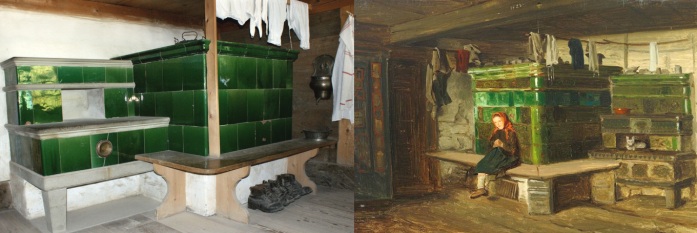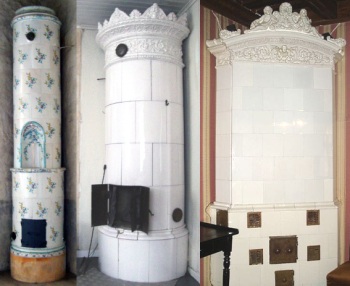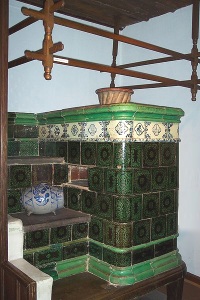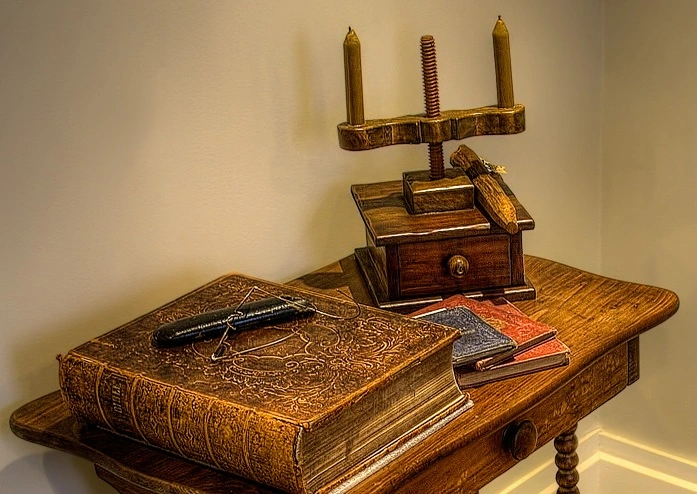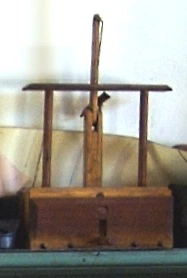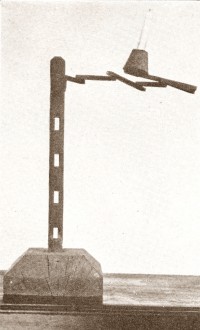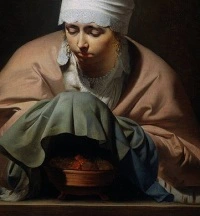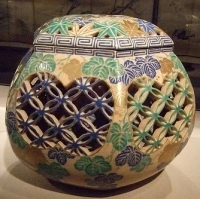
Ceramic hot water bottles were common in the 19th and early 20th centuries. As well as filling hot water containers to warm your bed, you could buy earthenware bottles to use as foot warmers or hand warmers too. Earlier foot warmers used to hold hot coals, or glowing wood, not warm water. In the same way, traditional bed warmers filled with embers were once more usual than hot water bottles.
If you were travelling in cold weather you would hope to have a foot warmer of some kind in your unheated carriage, sleigh, or train compartment. In the 17th and 18th centuries a pierced metal carrier for hot coals was a common solution for anyone who could afford one. They went on being used in the 19th century, while other styles of foot warmer came along too.
The simplest were punched tin in a wooden frame with an earthenware or iron pot inside. Brass was more stylish, and silver warmers were used by the wealthy, although you couldn’t actually rest your feet on them. Poor people travelling by wagon or sled could carry pre-heated stones or bricks with them, or even baked potatoes and flatirons, as described in Laura Ingalls Wilder’s books.

In the US these warmers were called foot stoves and were taken to church on winter Sundays to keep feet warm during long services. It seems the name and style was inspired by the Dutch style of foot warmer, called a stoof or stove, discussed below.
In bitter winter weather women carried to meeting little foot-stoves – metal boxes which stood on legs and were filled with hot coals at home, and a second time during the morning from the hearthstone of a neighbouring farm-house or a noon-house. These foot-warmers helped to make endurable to the goodwives the icy chill of the meeting-house; and round their mother’s foot-stove the shivering little children sat on their low crickets, warming their half-frozen fingers.
Alice Morse Earle, Sabbath in Puritan New England, 1891
As rail travel took off, foot warmers moved onto trains. First class rail services in cool climates often supplied foot warmers. These might be metal or earthenware containers for hot water, metal holders with hot brick slugs or even chemicals inside. Some later trains were designed with built-in “foot warmers”: areas of the floor with heated piping running underneath, for example. Early cars followed the same pattern. Before the days of fully heated vehicles foot warmers were included in the design.
Dutch foot stoves

The Dutch used to be known for a certain kind of foot warmer found alongside other household furniture: a pierced box with an earthenware or metal pot holding glowing coals inside. They called it a stoof (stove) and you can see it in countless paintings from the 17th century on, like this one by Cornelis de Man c1670.

These foot stoves were also common in northern Germany. A stone slab was an alternative to the wooden top with holes. Similar foot-warming “boxes” were known in other countries too: see this French chaufferette. In Britain open fires were the most popular way of warming yourself indoors and foot warmers were not much used in the home, but some craftspeople had an earthenware pot of coals for heating their workshop, and this might be placed under a footstool.
Foot warmers are visible in the paintings, but they could be completely hidden under a long skirt or cloak. They were used more by women than men. Did men’s boots keep them warmer?
More on the Mecca foot warmer and other ceramic foot warmers
After the first plain cream queensware “Mecca” warmer in 1910 (“finest English Ivory Queens Ware”), they were made in various other “Royal Winton” decorative finishes and several different sizes.
Grimwades Ltd., Stoke-on-Trent, one of the best-known firms manufacturing an exhaustive range of popularly priced, useful and ornamental earthenware and china, and famous for their hygienic wares for the kitchen and pantry….An unique feature of the exhibit is the Mecca bed-bottle or foot-warmer in a variety of choice decorations. What nicer present for an invalid friend or wounded soldier!
1915 Guardian report on the British Industries Fair

A more common shape of earthenware foot warmer, popular in the UK, was made by many different manufacturers (see photo left). Doulton’s were lent to passengers on an English railway.
Pictures
Photographers credited in captions. Links to originals here: wooden “stove” with holes, stone-top foot warmer, earthenware warmers. Also see this post on making your own tin foot warmer. More picture info here
//
http://pagead2.googlesyndication.com/pagead/show_ads.js
